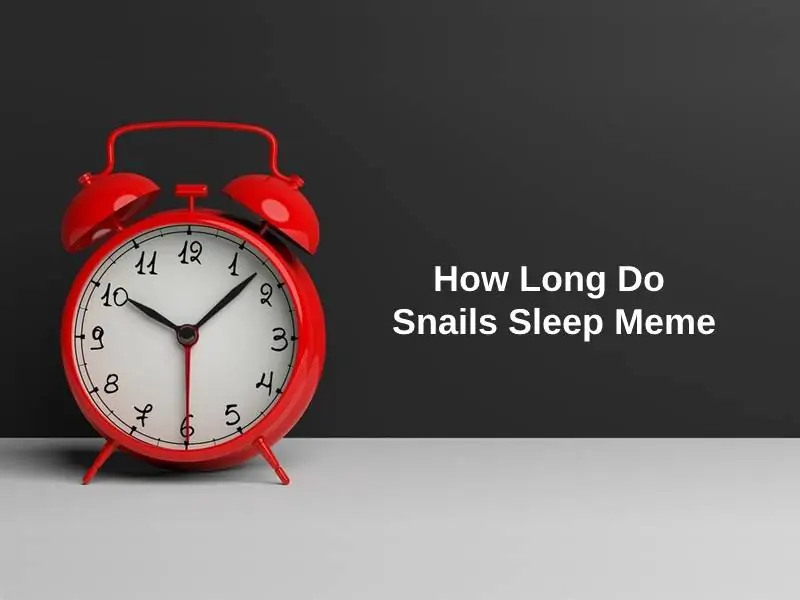Exact Answer: Up to 3 years
Snails are gastropods that inhabit different natural environments. There are various types, shapes, and varieties of snails found in diverse habitats. The most curious aspect that has intrigued the common man about these hermaphrodite creatures is the Google search result that is displayed when their sleeping schedules are researched.
Initially, when a certain Reddit user searched for an answer to this question the immediate result suggested by the Google algorithm was 3. The lack of a subsequent measuring unit inspired the development of several memes on the issue. Most of these memes comically ridiculed the prolonged sleeping cycle of a snail and compared it to the sleeping pattern of some humans. Some also went to the extent of comparing it to a comatose state.

How Long Do Snails Sleep Meme?
The stated immediate answer that instigated the development of multiple ‘snails sleep memes’ on the internet was 3. The Google algorithm failed to display a unit of measurement after the number. However, in reality, the sleeping cycles of snails are as different as the sub-categories within the overarching species.
Generally, most snails sleep for a long duration extending from 13 to 15 hours a day. Within these hours, they complete about 7 sleep cycles, separated by intermittent periods of waking up.
Moreover, their sleep cycles are not bound by the norms of night and day. They continue to sleep for several hours during the day. Their sleep cycles are very different from the 24-hour cycles that most animals consider normal. After completing their quota of sleep for the day, most snails remain energized for the following 30 hours or so. They use this time to complete other chores.
Moreover, snails are nocturnal creatures. This means that they remain awake during the night and sleep during the day. Thus, it can be expected that the 15 hours of sleep a snail secures is mostly during the daytime.
Nonetheless, it is also true that some land snails can hibernate for up to 3 years. This hibernation period is triggered by a set of specific environmental conditions. They hibernate during the winter months. Snails can also aestivate during certain dry seasons. However, these are rather rare occurrences and thus, cannot be overgeneralized. These instances can be taken as an upper limit when assessing the sleep cycle of a snail.
In Summary:
| Sleeping Conditions | Duration of Sleep |
| Normal | 13-15 hours |
| Hibernation/ Aestivation | Up to 3 years |
Why Do Snails Sleep This Long?
The sleep cycle of a snail is determined by the conditions of its existence. If the snail is living under optimal conditions, it will sleep for 13 to 15 hours. Most of these hours will be during the night as the sun is detrimental to the mucus-filled body of a snail.
To avoid the heat from the sun’s rays, snail curls into their shells and sleep for prolonged durations. Moreover, on certain days when the moisture content of the air is higher or there is the probability of heavy rainfall, snails can be visible during the daytime. They are mostly awake at night as the dampness of the air is more palpable during this time.
However, when the weather becomes exceptionally cold, snails tend to slip into a phase of hibernation that can last up to 3 years. This is because extreme weather can threaten their survival. Most snails will curl up into their shells and seal them with a layer of mucus for about 3 years.
Snails enter into the aestivation or the summer sleep phase when the weather is too dry. They cannot survive without adequate moisture. Thus, under such extreme conditions, most snails aestivate. They come out of their shells when the external conditions are conducive to their survival.
The geographic location of the natural habitat of a snail also has a bearing on its periods of hibernation and aestivation. However, such prolonged sleeping periods are quite uncommon. Most snails will hibernate or aestivate for about a year. It is only in extremely rare instances when they remain dormant for up to 3 years.
Conclusion
Snails are one of the most commonly found creatures in both land and water ecosystems. They are most commonly visible during the monsoon season. The sleep cycle of a snail is one of the most interesting aspects of its life course.
Unlike humans and other animals, snails sleep for a prolonged period of time extending from 13 to 15 hours. Their sleep cycles can be further extended to cover months and even years under special environmental conditions. When the harsh external conditions threaten the mucus content of a snail, it slips into a period of hibernation or aestivation, lasting up to 3 years.